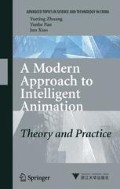Abstract
The ability to extract human motion data from video is very important in intelligent animation. Videos are abundant in our daily life and the cost to make videos is becoming lower. If the 2D/3D human motion data required for producing animations can be easily and rapidly extracted from existing videos, the cost will be reduced and the efficiency will be improved significantly.
Access this chapter
Tax calculation will be finalised at checkout
Purchases are for personal use only
Preview
Unable to display preview. Download preview PDF.
References
O’Rourke J, Badler NI. Model-based image analysis of human motion using constraint propagation. IEEE Transactions on Pattern Analysis and Machine Intelligence, 2(6). 522–536, 1980.
Hogg D. A program to see a walking person. Image Vision Computing, 1(1). 5–20, 1983.
Rohr K. Incremental recognition of pedestrians from image sequences. In: Computer Vision and Pattern Recognition, pp. 8–13, IEEE Computer Society, 1993.
Chen Z, Lee HJ. Knowledge-guided visual perception of 3D human gait from a single image sequence. IEEE Transactions on Systems, Man, and Cybernetics, 22(2). 336–342, 1992.
Bharatkumar AG, Daigle KE, Pandy MG, Cai Q, Aggarwal JK. Low limb kinematics of human walking with the medial axis transformation. In: Workshop on Motion of Non-Rigid and Articulated Objects, pp. 70–76, IEEE Computer Society, 1994.
Akita K. Image sequence analysis of real world human motion. Pattern Recognition, 17(1): 73–83, 1984.
Bregler C, Malik J. Video motion capture. UC Berkeley, Technical Report CSD-97-973. http.//www, cs. berkeley, edu/~ bregler/breglermalik-sig98, ps. gz.
Aggarwal JK, Cai Q. Human motion analysis, a review. Computer Vision and Image Understanding, 73(3). 428–440, 1999.
Liu M, Yao H, Gao W. Real-time human face tracking in color images. Chinese Journal of Computer, 21(6): 527–532, 1998.
Kearney JK, Thompson WB. Bounding constraint propagation for optical flow estimation. In: Aggarwal JK and Martin W, ed. Motion Understanding, Kluwer, 1988.
Abdel-Malek A, Hasekioglu O, Bloomer J. Image segmentation via motion vector estimates. In: Medical Image IV. Image Processing, pp. 366–371, SHE, 1990.
Horprasert T, Harwood D, Davis L. A statistical approach for realtime robust background subtraction and shadow detection. In: ICCV Frame-Rate Workshop, IEEE Computer Society, 1999.
Haritaoglu I, Harwood D, Davis LS. W4: who.9 when? where? what? A real time system for detecting and tracking people. In: FGR’98, pp. 222–227, IEEE Computer Society, 1998.
Vignola J, Lalonde J, Bergevin R. Progressive human skeleton fitting. In: Proc of 16th Conference on Vision Interface, pp. 35–42, 2003.
Fujiyoshi H, Lipton A. Real-time human motion analysis by image skeletonisation. In: Proc of the Workshop on Application of Computer Vision, pp. 15–21, IEEE Computer Society, 1998.
Agarwal A, Triggs B. Recovering 3D human pose from monocular images. IEEE Transactions on Pattern Analysis and Machine Intelligence, 28(1): 44–58, 2006.
Chen Y, Lee J, Parent R, Machiraju R. Markerless monocular motion capture using image features and physical constraints. In: Computer Graphics International, pp. 36–43, 2005.
Rights and permissions
Copyright information
© 2008 Zhejiang University Press, Hangzhou and Springer-Verlag GmbH Berlin Heidelberg
About this chapter
Cite this chapter
(2008). Natural Video-based Human Motion Capture. In: A Modern Approach to Intelligent Animation. Advanced Topics in Science and Technology in China. Springer, Berlin, Heidelberg. https://doi.org/10.1007/978-3-540-73760-5_2
Download citation
DOI: https://doi.org/10.1007/978-3-540-73760-5_2
Publisher Name: Springer, Berlin, Heidelberg
Print ISBN: 978-3-540-73759-9
Online ISBN: 978-3-540-73760-5
eBook Packages: Computer ScienceComputer Science (R0)

